John Ottis Adams stands as a significant figure in the landscape of American art, particularly celebrated for his contributions to Impressionism in the American Midwest. Born on July 8, 1851, in Amity, Indiana, Adams's artistic journey was one of dedicated study, passionate regionalism, and influential teaching. His work, deeply rooted in the depiction of his native Indiana, helped to define a distinct regional variant of Impressionism and cemented his place as a key member of the renowned Hoosier Group of painters. His life, spanning until January 28, 1927, when he passed away in Muncie, Indiana, was a testament to the pursuit of artistic excellence and the nurturing of a vibrant local art scene.
Early Life and Artistic Awakening
From a young age, John Ottis Adams exhibited a profound enthusiasm for art. Growing up in the rural setting of Indiana, the natural beauty surrounding him likely provided early, albeit informal, inspiration. A pivotal moment in his youth, however, came when he encountered the work of William Merritt Chase. Chase, himself an Indiana native who would go on to become one of America's most prominent Impressionist painters and influential art educators, made a lasting impression on the young Adams. Seeing Chase's paintings ignited a spark, solidifying Adams's resolve to pursue a professional career as an artist. This early encounter with the work of a successful artist from his own state undoubtedly provided a tangible example of what was possible and set him on a path of formal artistic training.
This decision was not taken lightly in an era and region where art was not always seen as a viable profession. However, Adams's passion was strong. He understood that to achieve his ambitions, he would need to seek out rigorous instruction, a quest that would eventually take him far from the familiar landscapes of Indiana to the art capitals of Europe. His formative years were thus characterized by an earnest desire to learn and master the craft of painting.
Formative Years Abroad: London and Munich
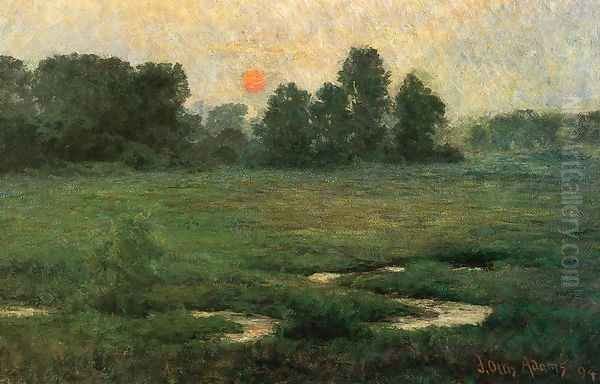
In 1872, at the age of twenty-one, John Ottis Adams embarked on his European studies, initially traveling to London. He enrolled at the South Kensington Art School (now the Royal College of Art), a prestigious institution known for its comprehensive curriculum. For two years, he immersed himself in his studies, likely under instructors such as John Parker, honing his foundational skills in drawing and painting. The London experience would have exposed him to a wide array of artistic traditions, from the classical works in British museums to contemporary Victorian art. This period was crucial for developing his technical proficiency and broadening his artistic horizons.
After his London sojourn, Adams returned to the United States in 1874. He settled in Muncie, Indiana, in 1876, where he demonstrated his entrepreneurial spirit by opening a portrait studio and gallery. He also began his lifelong commitment to art education by teaching local students. However, the desire for further advanced study remained. In 1880, Adams made the significant decision to return to Europe, this time choosing Germany as his destination. He enrolled in the Royal Academy of Fine Arts in Munich, a leading art center that attracted many American artists during this period.
The Munich art scene was known for its emphasis on vigorous brushwork, dark tonal palettes, and a realistic approach to subject matter, often influenced by 17th-century Dutch and Spanish masters like Frans Hals and Diego Velázquez. Artists like Wilhelm Leibl were prominent figures there. During his seven years in Munich, Adams studied alongside other aspiring artists, including fellow Indianans William Forsyth and Theodore Clement (T.C.) Steele. These connections proved to be incredibly important, as these artists would later form the core of the Hoosier Group. The Munich training provided Adams with a strong technical grounding, evident in the more somber tones and solid forms of his earlier works.
Return to Indiana and the Hoosier Group
Upon completing his studies in Munich in 1887, John Ottis Adams returned to Indiana, bringing with him a wealth of European academic training and a refined artistic sensibility. He, along with T.C. Steele, William Forsyth, Otto Stark, and Richard Buckner Gruelle, became central figures in what would be known as the Hoosier Group of Indiana Painters. This collective of artists, many of whom had shared experiences studying abroad, particularly in Munich, played a pivotal role in developing a regional school of American Impressionism.
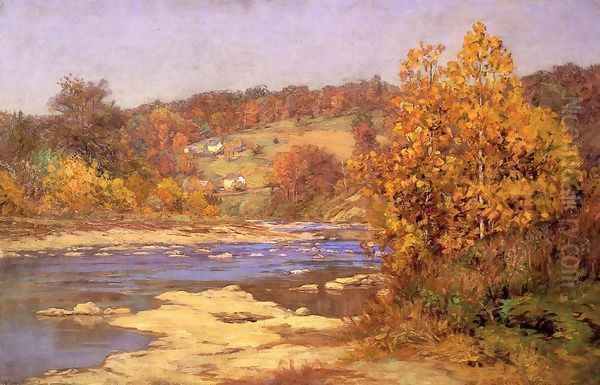
The Hoosier Group was not a formal organization with a manifesto, but rather a group of like-minded artists who often painted together, exhibited together, and shared a common goal: to depict the unique beauty of the Indiana landscape. Their work gained significant recognition following a landmark exhibition in Chicago in 1894 at the Denison Hotel, organized by the critic Hamlin Garland, which helped to popularize their distinct regional style. Adams was instrumental in this movement, both as a prolific painter and as a supportive colleague. His home in Muncie, and later the Hermitage in Brookville which he shared with T.C. Steele and his family, became important gathering places for these artists, fostering a collaborative and encouraging environment.
Adams, like his colleagues, was deeply committed to capturing the specific light, atmosphere, and character of their native state. They sought to find beauty in the everyday scenes of Indiana – its rolling hills, meandering rivers, and changing seasons. This focus on local subject matter, interpreted through the lens of Impressionist techniques, distinguished their work and contributed significantly to the cultural identity of the region.
Artistic Style and Evolution: From Tonalism to Impressionism
John Ottis Adams's artistic style underwent a significant evolution throughout his career, reflecting both his academic training and his embrace of contemporary artistic trends. His early works, influenced by his studies in Munich, often featured a darker, more tonal palette. These paintings, frequently depicting peasant life or somber landscapes, were characterized by a strong sense of realism, solid draftsmanship, and a rich, albeit subdued, color scheme. This approach was typical of the Munich School, which emphasized capturing the material reality of subjects with a certain gravitas.
However, by the 1890s, a noticeable shift occurred in Adams's work. Like many American artists of his generation, he began to absorb the principles of Impressionism, which had originated in France with artists such as Claude Monet, Camille Pissarro, and Alfred Sisley. This transition was marked by a significant brightening of his palette, a looser and more visible brushstroke, and a greater emphasis on capturing the fleeting effects of light and atmosphere. His focus shifted more exclusively to landscape painting, where these Impressionistic concerns could be most fully explored.
Adams did not simply replicate French Impressionism; rather, he adapted its techniques to suit his personal vision and the specific character of the Indiana landscape. His Impressionistic works are often characterized by a gentle lyricism and a deep appreciation for the subtleties of nature. He became adept at rendering the hazy light of an Indiana summer, the crisp air of autumn, or the delicate colors of wildflowers. This evolution towards a more Impressionistic style aligned him with other American Impressionists like Childe Hassam, J. Alden Weir, and Theodore Robinson, though Adams maintained a distinctly Midwestern voice.
Themes and Subject Matter: Celebrating the Indiana Landscape
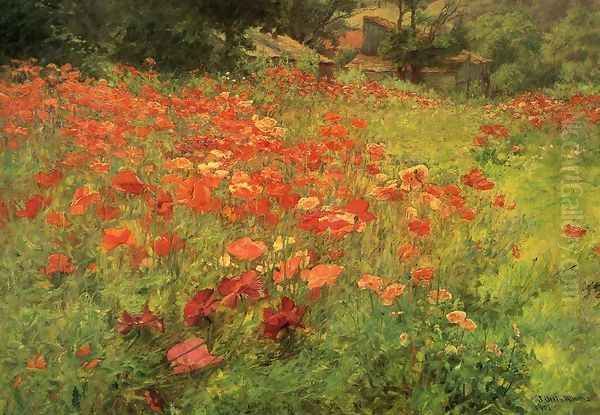
The predominant theme in John Ottis Adams's oeuvre was the landscape of his beloved Indiana. He possessed a profound connection to the natural environment of his home state and dedicated much of his career to capturing its diverse beauty. His paintings often feature the rolling hills, lush forests, winding rivers, and cultivated fields that characterize the Indiana countryside. He was particularly drawn to the picturesque scenery along the Whitewater River valley and the Muscatatuck River, finding endless inspiration in their tranquil waters and verdant banks.
Adams's landscapes are more than mere topographical records; they are imbued with a sense of atmosphere and emotion. He was skilled at conveying the specific mood of a scene, whether it was the quietude of a misty morning, the warmth of a summer afternoon, or the vibrant colors of an autumn day. His paintings often evoke a sense of peace and harmony, reflecting his deep appreciation for the natural world. While he occasionally painted scenes from Michigan or Florida, his primary focus remained the familiar and cherished landscapes of Indiana.
Beyond pure landscapes, Adams also depicted scenes of rural life, though these became less frequent as his Impressionistic style matured. His earlier works sometimes included figures engaged in agricultural activities, reflecting the agrarian character of the region. However, even in these pieces, the landscape often played a dominant role, serving as more than just a backdrop. His commitment to depicting local scenery was a hallmark of the Hoosier Group, who collectively helped to create a lasting artistic record of Indiana at the turn of the 20th century.
Notable Works: Capturing Light and Atmosphere
Several of John Ottis Adams's paintings stand out as exemplary of his artistic vision and technical skill. "Blue and Gold," for instance, likely showcases his mastery of color and light, using the contrasting hues to evoke a particular time of day or season, a common Impressionist concern. The title itself suggests a focus on the optical effects of color, a departure from purely narrative or descriptive painting.
"A Field in Late Summer" is another title that points directly to his engagement with the seasonal changes in the Indiana landscape. One can imagine a canvas filled with the warm, golden tones of late summer, perhaps with long shadows and a sense of ripening abundance. Such a work would demonstrate his ability to capture the specific character of a particular moment in the agricultural cycle, a theme resonant with the regional identity he and the Hoosier Group championed.
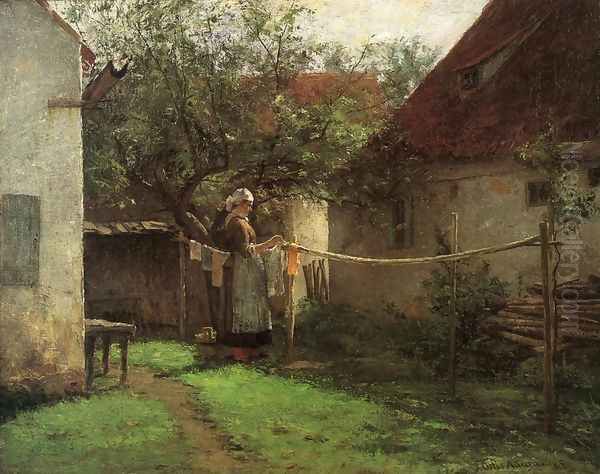
"In Poppyland" suggests a vibrant, colorful composition, likely featuring a field of poppies. This subject would have provided an excellent opportunity for Adams to explore the broken color and lively brushwork characteristic of Impressionism, similar to how Claude Monet famously depicted fields of poppies. The painting would celebrate the beauty of wildflowers and the play of light across a textured, colorful surface.
While "Misty Morning on the Mississippi" is mentioned, and Adams did travel, his primary focus was Indiana. If this work exists and is prominent, it would show his ability to capture atmospheric effects like fog and diffuse light, key elements of Impressionist landscape painting. Other significant works often cited include "The Ebb Tide," "An August Sunset," "Iridescence of a Shallow Stream," "A Winter's Day," and "Wash Day," each reflecting his keen observation of nature and his evolving Impressionistic technique. These paintings collectively demonstrate his dedication to portraying the nuanced beauty of the American Midwest.
Teaching and Legacy: Nurturing Future Generations
John Ottis Adams was not only a dedicated painter but also a passionate and influential art educator. His commitment to teaching began early in his career, when he offered instruction in Muncie after his initial return from London. This dedication continued and expanded significantly throughout his life. After his extended studies in Munich, he, along with William Forsyth, played a crucial role in establishing and teaching at the Art School in Fort Wayne, Indiana.
Perhaps his most significant contribution to art education was his involvement with what would become the Herron School of Art and Design in Indianapolis. Adams, along with T.C. Steele and other members of the Hoosier Group, was instrumental in the early development of this institution, which grew out of the Art Association of Indianapolis. He served as an instructor there for many years, shaping the skills and artistic philosophies of countless students. His teaching emphasized a strong foundation in drawing and a direct engagement with nature, encouraging students to paint en plein air (outdoors) to capture the immediate effects of light and color.
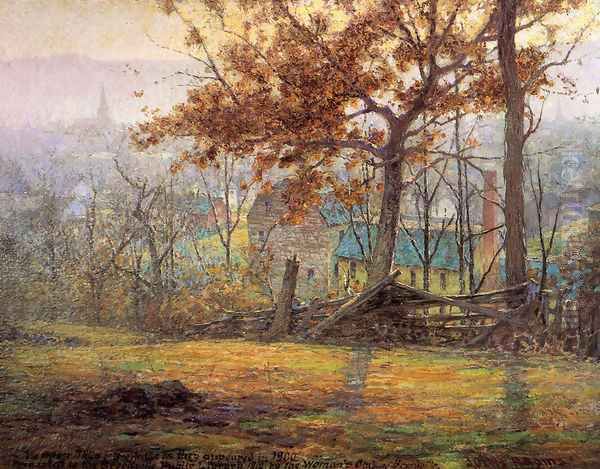
His wife, Winifred Brady Adams (1871-1955), was also a talented still-life and landscape painter, and together they created an artistic household. Their home, particularly "The Hermitage" in Brookville, which they shared with T.C. Steele and his family for a period, became a center for artistic activity and learning. Adams's legacy as an educator is profound; he helped to cultivate a vibrant art scene in Indiana and inspired a new generation of artists to appreciate and depict their local environment. His influence extended beyond his direct students, as his work and that of the Hoosier Group raised the profile of art in the region.
Exhibitions, Recognition, and Broader Context
Throughout his career, John Ottis Adams actively participated in exhibitions, both regionally and nationally, which helped to bring his work and that of the Hoosier Group to a wider audience. The 1894 exhibition of "Five Hoosier Painters" (Adams, Steele, Forsyth, Stark, and Gruelle) at the Denison Hotel in Chicago, championed by writer Hamlin Garland, was a pivotal moment. It garnered critical attention and helped to solidify the group's identity and reputation. This exhibition highlighted their shared commitment to depicting Indiana subjects with an Impressionistic sensibility.
Adams's work was also shown at major national venues, including the Pennsylvania Academy of the Fine Arts in Philadelphia and the National Academy of Design in New York. He received several awards for his paintings, including a notable $500 art prize in 1907, a significant sum at the time, which attested to the quality and appeal of his work. He was also involved in organizing artists and promoting art in the Midwest, co-founding the Western Artists Association, which aimed to provide more exhibition opportunities for artists working outside the established East Coast art centers.
In the broader context of American art, Adams and the Hoosier Group represent an important regional manifestation of Impressionism. While artists like Childe Hassam, Mary Cassatt, and John Henry Twachtman were developing their Impressionist styles, often with closer ties to French developments or East Coast art circles, Adams and his colleagues forged a distinct path. They adapted Impressionist techniques to the unique landscapes and cultural milieu of the American Midwest, creating art that was both modern in its approach and deeply connected to its place of origin. Their efforts paralleled those of other regional Impressionist schools, such as the California Impressionists, who similarly focused on capturing the specific light and scenery of their respective areas.
Personal Life and Artistic Community
John Ottis Adams's personal life was deeply intertwined with his artistic pursuits and the community of artists he helped to foster. His marriage to Winifred Brady, herself an accomplished artist, created a partnership grounded in shared artistic passions. Winifred specialized in still life and landscape painting, and her presence undoubtedly contributed to the rich artistic environment of their home. Their residence, particularly "The Hermitage" in Brookville, which they co-occupied with T.C. Steele and his family for a number of years, was more than just a home; it was a vibrant hub for the Hoosier Group.
This communal living and working arrangement fostered a supportive and collaborative atmosphere. Artists would gather to paint, discuss ideas, and offer mutual encouragement. Such an environment was crucial for the development of their individual styles and the collective identity of the Hoosier Group. The camaraderie among these artists – Adams, Steele, Forsyth, Stark, and Gruelle – was a defining feature of their movement. They often embarked on sketching trips together, exploring the Indiana countryside and capturing its beauty en plein air.
This sense of community extended to their role as educators and mentors. Adams, through his teaching and his welcoming home, helped to nurture a younger generation of Indiana artists. His influence, therefore, was not limited to his own canvases but was amplified through the students he taught and the artistic culture he helped to build. His life demonstrates the importance of both individual talent and a supportive artistic network in the flourishing of a regional art movement.
Enduring Impact and Conclusion
John Ottis Adams left an indelible mark on American art, particularly within his native Indiana. As a leading figure of the Hoosier Group, he played a crucial role in popularizing Impressionism in the Midwest and in establishing a respected regional school of landscape painting. His dedication to capturing the unique beauty of the Indiana landscape, with its subtle light and distinctive seasonal changes, resulted in a body of work that continues to resonate with viewers today.
His evolution from the darker, tonal qualities of the Munich School to the brighter, more luminous palette of Impressionism reflects his engagement with the major artistic currents of his time. Yet, he always adapted these influences to his own vision and the specific character of his chosen subjects. His paintings are celebrated for their lyrical beauty, their sensitive rendering of atmosphere, and their heartfelt appreciation for the natural world.
Beyond his achievements as a painter, Adams's legacy is also firmly established through his contributions as an art educator. His long tenure at what became the Herron School of Art and Design, and his earlier teaching efforts, helped to train and inspire generations of artists. He instilled in his students a respect for sound technique, a love for nature, and the importance of direct observation.
John Ottis Adams, alongside his colleagues in the Hoosier Group like T.C. Steele, William Forsyth, Otto Stark, and Richard Buckner Gruelle, helped to create a vibrant artistic culture in Indiana. They demonstrated that significant art could be produced outside of the major East Coast art centers and that regional subjects were worthy of serious artistic exploration. His work remains a testament to the enduring appeal of the American landscape and the power of art to capture the spirit of a place. His contributions ensure his position as a distinguished and beloved figure in the history of American Impressionism.